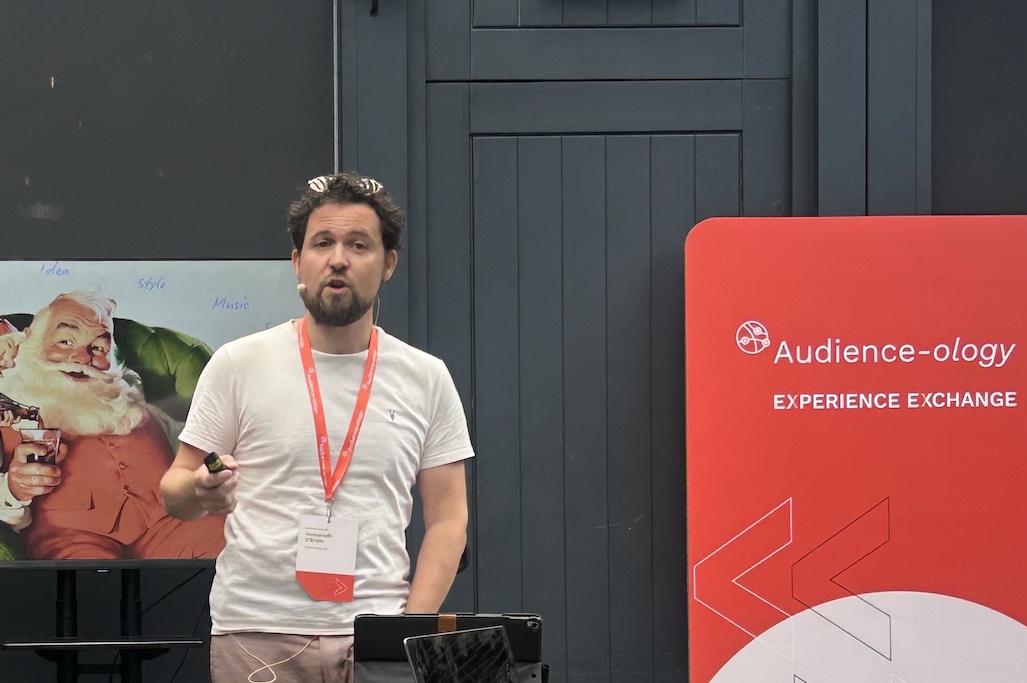Last month, Audience hosted the latest in its Audience-ology Experience Exchange series, bringing together marketing and event leaders from brands including Google, BBC, Deloitte, Warner Music Group, Hiscox and more to explore the importance of storytelling and emotional engagement in marketing and events. And micebook was invited to join the interactive and insightful session, led by Olivier Award-winning Creative Director, Donnacadh O’Briain.
In a fabulous rooftop setting at The Conduit in Covent Garden, O’Briain set the scene by discussing the human brain’s role as a story processor, and the importance of narratives in understanding the world.
“Stories are the most persuasive form of human communication, validating, challenging, and inspiring us,” he explained, before delving into Aristotle’s principles of storytelling, emphasising the need for a causal plot, consistent characters, and a fundamental idea or moral. He also highlighted the emotional impact of stories, and their power to develop trust and motivate audiences to act.
Below, the team at Audience has distilled the core insights from the day into five actionable recommendations, designed to help brands translate conversation into impact.
1. Speak the language of story with confidence
Key Insight: Story is a universal language, and we absorb its patterns from a young age. But understanding stories and crafting them are two different skills. The good news? You’re not starting from scratch. You already know more than you think.
Our recommendation: Invest in developing your team’s storytelling fluency. Introduce shared frameworks (like the Hero’s Journey) and create space for teams to practice story-led thinking. Building this muscle enables everyone, from marketers to event planners, to construct experiences that resonate emotionally and stay with audiences longer
2. Master the architecture of emotional engagement
Key insight: Behind every compelling story is a structure designed to move people – emotionally and behaviourally. Marketers and experience creators who understand the fundamentals of story architecture gain a major advantage: they can design moments that feel meaningful and drive action.
Our recommendation: Ground your creative process in the timeless principles of narrative: tension, transformation, resolution. Use story beats to build your experiences, from customer journey flows to keynote content. This structure doesn’t limit creativity, it amplifies it by focusing on what truly moves people.
3. Make your customer the hero of the story
Key insight: The most effective brand experiences don’t spotlight the brand, they centre the customer. In this story model, the brand becomes the mentor, the product a magical object, and the customer the hero, solving a real problem with meaningful stakes.
Our recommendation: Reframe your messaging and experience design around your customer’s journey. Ask the questions – what challenge are they facing? How can your brand help them overcome it? What’s at stake if they succeed? Craft narratives that show, not just tell, the impact of what you offer and build stronger emotional connections in the process.
4. Use story to sustain attention and build memory
Key Insight: Attention is fleeting, but stories endure. Our brains are wired to remember emotionally charged narratives far longer than raw facts. If you want your audience to feel something and remember you, storytelling is your most powerful tool.
Our recommendation: Build your experiences with narrative pacing in mind. Lead with emotion, build suspense, deliver payoff. Whether you’re designing a conference keynote or a digital campaign, use storytelling arcs to guide attention and keep audiences engaged from start to finish.
5. Reignite your creative instincts
Key insight: Everyone is creative. Creativity is a natural human function that may go dormant, but never disappears. With the right tools and mindset shifts, you can unlock new ideas and approaches on demand.
Our recommendation: Encourage playful thinking across your team. Use improvisation techniques, physical movement, or simple reframing exercises to shift from logic mode to creative mode. Treat creative development like a practice, not a performance, and watch their confidence grow.

